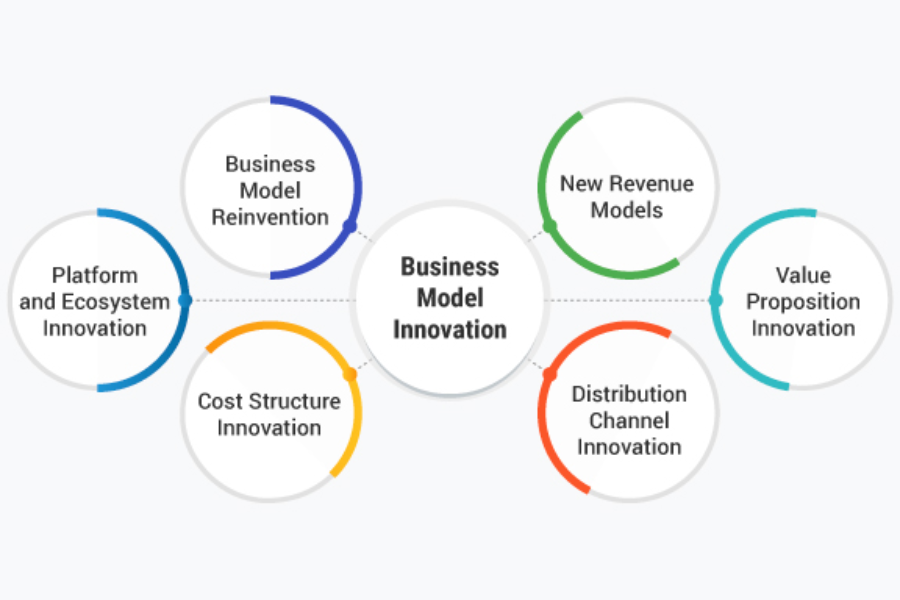90% of company managers do not question the business model of their blogs. Rethinking how to develop innovative business models or investigate other types of business models for your company is one of the main tasks that anyone with responsibility in Startups, SMEs or consolidated companies should perform.
“Questioning” my business model implies thinking about how our company or entrepreneurial business project adds value to clients and how they pay for that value they receive. In addition, it is important to know the type of market in which we operate and what other factors influence it.
At the beginning of the 20th century, the business model of a company, in general, was rather simple; A company made a product or performed a service and charged for it.
The evolution of society, uncertainty, the speed of change, the Internet, technological advances and the birth of new needs and therefore new opportunities, have forced companies to generate new innovative business models , as alternative ways of generating income .
In this post, we are going to see what a business model is for, in addition to some examples of innovative projects in the world, which are so because, based on innovative ideas, they have been able to find a market niche like email marketing , a target customer using free smtp servers if you don’t know what is SMTP or simple mail transfer protocol,
Or automate a problem using free autoresponder tools in your innovative business model.
A few examples of companies that have developed types of innovative business models
If we look back, there are some examples of innovative business projects in Spain, introduced by large companies worldwide, which dared to innovate, to rise from their ashes. Examples of innovation such as www.smtpservers.co or Gillette illustrate this “resurgence” when their positions in the market were threatened.
Others, however, could not see what was coming from their privileged position, such as Kodak. In its day it was one of the innovative businesses in the world, which collapsed with the arrival of digital photography.
Definition of business model
The business model refers to the way in which the company creates, captures and offers value to its customers. In other words, it is the way in which the company creates value for itself and its customers by transforming raw materials into a finished product and selling that final product to the customer.
Description of innovative business models
In 2003 IBM changed its business model and its model of generating business, going from the manufacture and sale of computers and hardware, to a business based on offering innovative services and information technology (IT) solutions. It sold its PC development unit to Lenovo , its hard drive unit to Cisco, and its printer unit to Lexmark .
With this example of an innovative idea, IBM became the world’s largest outsourcing, consulting and data recovery services company in the world, overturning hitherto known types of business models.
Gillette modified its business model for the sale of quality razors, lowering the price to make them accessible to almost everyone, with the aim of generating income from the sale of spare parts; razor blades. That simple change brought one of the most innovative business models to the market and is a case study in many schools.
The great competitiveness, the Internet, and the speed of birth, evolution and disappearance of startups, has generated a whole list of new business models, business models and pure innovative business ideas or a mixture of several existing ones.
We are going to review the most interesting ones:
Long-tail business model
Term coined by Chris Anderson in 2004, it is one of the most innovative business models that have emerged in recent times. The innovation of the long-tail business model is characterized by offering a wide range of items with little demand, but which can become profitable businesses and generate profits due to a large volume of small sales .
In the traditional model, the one governed by the Pareto Principle , 80% of the population bought 20% of the items. This fact made less profitable products less sold, due to the high costs of development, storage, distribution and marketing.
To save costs, companies limited their production and marketing only to the best-selling items, that is, 20%.
But with the arrival of the Internet , new innovative business models have been generated, which consist of having a huge range of products with little demand, but which become profitable businesses for being able to sell worldwide, which together generates a high turnover using best free email services.
This type of business model is especially interesting when it comes to selling software ( Google Play ), digital ( Itunes, Grooveshark ) products and even for physical products ( Amazon or Ebay ). You are sure to come up with other innovative business ideas.
Bait and hook or tied products
The novelty introduced by the innovative idea of Bait and Hook consists of offering a basic product at a very low price , Eg you can see the business model of either sendinblue or constant contact. They offer services at such lower costs almost at free. Check out our review of Sendinblue, Review of Constant Contact here. Often with losses for the company that offers it (bait) and then charging high prices for the associated product, spare parts or services (hook).
Examples of this type of business model are the blogs that “give away” the mobile phone (bait) in exchange for a contract of permanence for a certain time (hook). The user feels that they are given the phone as a gift, but the company recovers the investment and earns money on the monthly billing of the service during the contracted period.
Another example of this type of business model are companies that develop almost free software (SAGE) and then you must pay for updates, maintenance and even technical incident inquiries.
Multilateral platforms
As Alex Osterwalder explains in his book Generating Business Models , multilateral platforms are based on business models that bring together two or more distinct but interdependent customer groups .
In this type of business model, there is only interest if all the actors involved find a value proposition and therefore all are present. Multilateral platforms provide the channel that allows interaction between groups, and therefore its value increases as the number of users who use it increases.
An example of market innovation in this type of platform is the Puromarketing website , where quality free content is offered to a large number of users or you can hire companies like trustmypaper and supremedissertations to help in your content needs. Puromarketing income is obtained from the advertising of companies that want to take advantage of the traffic generated by this content website.
Google is another example of an innovative business model, where the vast majority are users who do not pay, but generate profits thanks to a percentage of companies or people who pay for some services such as Google Adwords . These companies pay because behind there are a lot of free users, who are the target audience of the advertising companies.
( Download the business model canvas in pdf )
Free as a disruptive business model
In this model, at least one of the actors involved benefits from a free offer. To do this, another part of the customer segment must finance the products or services that are offered free of charge to the other party or segment. In recent years, product and service offerings, especially on the Internet, have grown exponentially. Advertising or the Freemium model are some of the mechanisms that support being able to offer free services to a part of the users.
The Freemium business model consists of offering basic services free of charge, charging for Premium services a monthly fee or a payment per use. On the Internet there are countless examples of this type of business model; Unbounce, Dropbox, Linkedin or Spotify .
Affiliate business model
In this business model, the company that wants to sell a product or service establishes some type of reward for suppliers, companies or people who attract customers or orders for their products. These types of business models are based on a commission or reward.
An example of an offline affiliation business model is organized trips, which take tourists to eat at this or that restaurant, or to visit this or that craft factory, because they receive a commission for each person who eats in the restaurant or buys. in the factory.
With the advent of the Internet, innovation in the business model has also arrived and has gone online. The owner of a website, rents space for third parties to place their ads. They are based on the amount of traffic that they are able to derive to the client’s website. Hence, the company that needs to attract traffic offers gifts to agents (people, companies or websites) that can get these new visitors.
A very clear example of this affiliate business model are the blogs of any subject that publish third-party advertisements.
For example, in this blog we can include an affiliate banner to test the social sharing plugin that we use or one of the hosting providers that we also use in our projects. If you click on the banner and buy, we take a commission (small ;-))
In these business models it is important to measure 2 ratios :
- Number of people who register with respect to the number of people who visit the web.
- Number of people who buy compared to the number of people who register.
Both data are important and will allow us to make decisions to refocus the web strategy or redesign our business model.
In any case, it is essential for the business model to be profitable that the cost of acquiring a new customer is less than the profit obtained by that customer . Otherwise, affiliate business models are doomed to fail. Some examples of company projects are Bonusralia or Ono .
Franchise or license business model
It is a business model where a company or natural person that has successful and recognized products or services in the market, allows other people or companies to exploit its brand image, its products or services, under the supervision of the business owner , in exchange for a royalty .
This type of business model, franchise, allows entrepreneurs or investors to bet on exploiting a business that is already proven, that works and that “only” is replicated in a place where it does not yet exist. The clearest advantage is to take advantage of the brand image that already exists and is positioned in the market, to have clients almost before opening the business and above all to have the help and support of the franchise in the first steps.
The disadvantages are: the royalty that must be paid to exploit the franchise, the fact that the franchisee is more limited in making decisions and naturally because a franchise does not assure you success, however they are booming businesses and especially, they can turn into profitable businesses in times of crisis. For example, the 100 Montaditos or Equivalenza franchise has managed to develop innovative profitable franchise businesses and expand internationally, even in times of crisis.
Subscription business model
It is a classic business model, but taken to other market sectors it is a totally new business model. The model consists in that the user pays a subscription and in return receives a value proposition that compensates the fee that he pays. Classic examples are subscriptions to magazines, newspapers or television channels.
I recently visited Bodegas Casa Primicia in Laguardia (La Rioja Alavesa) and in addition to their main business model, the production and sale of wines, they had started a new business line: the Casa Primicia Brotherhood. For an annual subscription you can enjoy its facilities, rooms, gardens, vineyards and also be the owner of a barrel kept in the original cellar of the House.
The innovation in the business model not only means developing new business models, but by adapting and combining existing business models to other market segments.
Check out the latest blog on SendinBlue Vs Mailchimp – Complete Comparison!
Another example is a restaurant that runs away from the traditional model of: I prepare food, customers come, I sell food. You can innovate by applying the subscription business model through paying customers who can enjoy other services in addition to the traditional one of a restaurant, such as wine tastings, special dinners or interesting meetings and gatherings.
I also leave you a very interesting article with some of the ideas for innovative projects that are supposed to revolutionize the world soon. ( Innovative business ideas examples )
Checkout the full blog about “what is netsuite”.














Leave a Reply